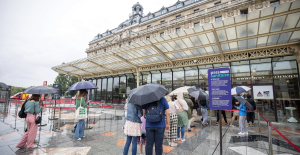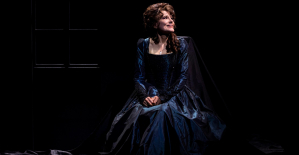It's wild, and that's the way it has to be. “Pirates” have been captured and are greeted on the island of Lesbos by naked women with castration tools. It is a slaughter and a pleasure that one bitterly regrets having considered becoming a pirate as a child.
Nicole Eisenman watercolored the scene with earthy, somber brilliance. “Insanely funny” is what one reads in the exhibition catalogue. In any case, the painting "Captured Pirates on the Island of Lesbos" is a strong mood-maker in the Munich exhibition, which recapitulates three decades of work development of the American painter.
In the early 1990s, showing the fantasies of the lesbian community in downtown New York galleries was not without risk. Especially since Nicole Eisenman came up trumps with giant formats, on which it is preferred to hit, stab, hang and fuck, and the naked bodies form junk-like heaps, so that one thinks of Dante's ninth circle of hell. Violent humanity seems to lack the seriousness it deserves.
"Insanely funny" is a bit of an exaggeration. But if you come across drawings like "Jesus fucking Christ" or "I want to make love" - "Go fuck yourself" on the picture walls, then it's already obvious that the artist maintains a very casual relationship with the noble traditions and that's it cynically borrowed from classic styles, genres and patterns, as if it all depended on updating cultural gadgets accordingly. It's obvious that she enjoys the confusion and lacks all dogged seriousness. And people's attention was drawn to the work accordingly quickly.
In the retrospective in the Brandhorst Museum, one can once again experience the very unique mixture of spontaneity and thoughtfulness up close. The exhibition tries extremely successfully to reconstruct the early mix of styles, the adaptation of iconic patterns of male art history, the ironic historicism in which cheerful irrelevance mixes with explicit claims to content. The artist repeatedly reacts to American politics, to the Bush years and the Iraq war, and later to the Trump era. But it's feminist critique that gets involved in a more playful way and calls things by their proper name using comics and caricatures.
And you have to have learned to read or see the swelling imagery in order to be able to make sense of the fall height of obvious mockery and hidden seriousness in front of an almost cinema screen-sized mural like "Minotaur Hunt and Penelope in the pit". You're never sure what to expect when you turn the corner. Sometimes "Trash Dance", sometimes "Gay Parade for Absolut Vodka", sometimes Rubens gestures, sometimes painter prince attitude, sometimes cheeky borrowings from pop art jokes, sometimes theft of quotes from the archive of bourgeois erudition - Nicole Eisenman lives in a psychoanalyst household grew up. And the group of self-portraits already makes it clear that looking in a mirror must always have been preceded by at least an imaginary self-image.
“Coping” is also a term from the psycho scene. Coping is one of Eisenman's strangest images of 2008. People stand in a small town square, stumbling about in a brownish mass that's waist-deep. Mud or whatever, you don't really know.
It doesn't look like disaster, the clouds have cleared and there can be no talk of unrest after a flood disaster. Everyone is on their own, holding something under their arm or on their arm. Whatever the case, the danger seems to have been overcome, the stubborn life goes on. Quite similar to the beer gardens, which the painter devotes herself to with a fervor that turns the obvious Manet or Liebermann model into satirical evil. Naturally, things are different here, more violent than in the flooded village. And the visages of the beer mug-heaving leisure society dissolve into masks that decline all nuances of appearance between stupid and sinister.
Then the scene "The Triumph of Poverty" unleashes itself completely. A group, one thinks of survivors from George Grosz' disfigured 1920s population, forms a procession. Led by a moronic man in a top hat, who lets his bare buttocks and stomach protrude from the open shirt and pants and pulls puppets from Pieter Bruegel's “Blindenfallen” behind him on a thread. This is, if you will, Nicole Eisenman in one picture: loud, deathly silent, secretive, audible, abysmal, enigmatic, everything is there and always so there that one cannot say what is really there.
Perhaps the elusiveness that appears so sensuous is also the reason for the aggression that sometimes befalls the work. Eisenman was involved in Kasper König's last "Sculpture Projects" in Münster with a kind of fountain installation ("Sketch for a Fountain"). Far out in the park at the Buddenturm, a monstrous quintet of figures lolled, from which water gushed out of every possible orifice into a small pool. Two bronze, three plaster, larger than life, an oddly pimped-out species with no defined gender.
A bit of “Déjeuner sur l’herbe” by Manet, but twisted into the bizarre. Loitering around didn't look like true self-indulgence. Something seemed to have made the entertainment group sluggish and their roughened silhouettes likened to the old trees above them. And it wasn't long before the citizens' perplexity stored up enough anger to destroy the ensemble. A head was cut off, another crumbled. The fact that the iconoclast for its part established a - successful - initiative to restore the sculpture is not a bad indication of the resilience of the emotions that this work repeatedly unleashes. Even "insanely funny" is only the helpless admission of an unexplained alienation.
It's actually a mild miracle what the classic media of art still achieve. Nothing seems used up, nothing really done away with. No AI controls this work, no digital animation brings contemporary life to Nicole Eisenman's painted and drawn images. And there is no subject that one cannot think about in terms of painting or drawing. Queer love unleashes no fewer images than the narcissism that the artist observes in her smartphone generation.
This basic trust in the traditional medium, in the non-technical, i.e. owed to head and hands, representability and showability makes the Munich exhibition a pleasurable event. And seen in this way, the scandal of the pirate emasculation is nothing less than an illustrated report from the inside of the head, which seems somewhat helplessly described as "massacre and sex". More of an image of waking up from bad dreams, capturing the moment when you let things happen for a while with your eyes not fully open.
Nicole Eisenman: What Happened. Until September 10th in the Museum Brandhorst in Munich

 B:SM will break its investment record this year with 62 million euros
B:SM will break its investment record this year with 62 million euros War in Ukraine: when kyiv attacks Russia with inflatable balloons loaded with explosives
War in Ukraine: when kyiv attacks Russia with inflatable balloons loaded with explosives United States: divided on the question of presidential immunity, the Supreme Court offers respite to Trump
United States: divided on the question of presidential immunity, the Supreme Court offers respite to Trump Maurizio Molinari: “the Scurati affair, a European injury”
Maurizio Molinari: “the Scurati affair, a European injury” Irritable bowel syndrome: the effectiveness of low-carbohydrate diets is confirmed
Irritable bowel syndrome: the effectiveness of low-carbohydrate diets is confirmed Beware of the three main sources of poisoning in children
Beware of the three main sources of poisoning in children First three cases of “native” cholera confirmed in Mayotte
First three cases of “native” cholera confirmed in Mayotte Meningitis: compulsory vaccination for babies will be extended in 2025
Meningitis: compulsory vaccination for babies will be extended in 2025 Thanks to intelligent cameras, RATP will indicate the least crowded trains on line 14
Thanks to intelligent cameras, RATP will indicate the least crowded trains on line 14 Dubai begins the transformation of Al-Maktoum to make it the future “largest airport in the world”
Dubai begins the transformation of Al-Maktoum to make it the future “largest airport in the world” When traveling abroad, money is a source of stress for seven out of ten French people
When traveling abroad, money is a source of stress for seven out of ten French people Elon Musk arrives in China to negotiate data transfer and deployment of Tesla autopilot
Elon Musk arrives in China to negotiate data transfer and deployment of Tesla autopilot Two people arrested for attempted damage to classified property at the Musée d’Orsay
Two people arrested for attempted damage to classified property at the Musée d’Orsay Death of composer Jean Musy, at 76, author of the music of Papy fait de la resistance, Les Champs-Élysées
Death of composer Jean Musy, at 76, author of the music of Papy fait de la resistance, Les Champs-Élysées Fanny Ardant prodigious in The Wound and the Thirst
Fanny Ardant prodigious in The Wound and the Thirst Hospitalized for pneumonia, Véronique Sanson cancels her concert in Nantes
Hospitalized for pneumonia, Véronique Sanson cancels her concert in Nantes Skoda Kodiaq 2024: a 'beast' plug-in hybrid SUV
Skoda Kodiaq 2024: a 'beast' plug-in hybrid SUV Tesla launches a new Model Y with 600 km of autonomy at a "more accessible price"
Tesla launches a new Model Y with 600 km of autonomy at a "more accessible price" The 10 best-selling cars in March 2024 in Spain: sales fall due to Easter
The 10 best-selling cars in March 2024 in Spain: sales fall due to Easter A private jet company buys more than 100 flying cars
A private jet company buys more than 100 flying cars This is how housing prices have changed in Spain in the last decade
This is how housing prices have changed in Spain in the last decade The home mortgage firm drops 10% in January and interest soars to 3.46%
The home mortgage firm drops 10% in January and interest soars to 3.46% The jewel of the Rocío de Nagüeles urbanization: a dream villa in Marbella
The jewel of the Rocío de Nagüeles urbanization: a dream villa in Marbella Rental prices grow by 7.3% in February: where does it go up and where does it go down?
Rental prices grow by 7.3% in February: where does it go up and where does it go down? Europeans: a senior official on the National Rally list
Europeans: a senior official on the National Rally list Blockade of Sciences Po: the right denounces a “drift”, the government charges the rebels
Blockade of Sciences Po: the right denounces a “drift”, the government charges the rebels Even on a mission for NATO, the Charles-de-Gaulle remains under French control, Lecornu responds to Mélenchon
Even on a mission for NATO, the Charles-de-Gaulle remains under French control, Lecornu responds to Mélenchon “Deadly Europe”, “economic decline”, immigration… What to remember from Emmanuel Macron’s speech at the Sorbonne
“Deadly Europe”, “economic decline”, immigration… What to remember from Emmanuel Macron’s speech at the Sorbonne These French cities that will boycott the World Cup in Qatar
These French cities that will boycott the World Cup in Qatar Mercato: Fonseca coach of AC Milan? The Lille coach speaks
Mercato: Fonseca coach of AC Milan? The Lille coach speaks Ligue 1: OM with a three-way defense, Lens changes almost nothing
Ligue 1: OM with a three-way defense, Lens changes almost nothing Ligue 1: PSG officially crowned champion of France for the 12th time
Ligue 1: PSG officially crowned champion of France for the 12th time Ligue 1: Lyon offers Monaco and gets closer to a European place
Ligue 1: Lyon offers Monaco and gets closer to a European place

















